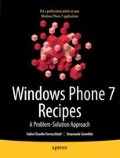Abstract
In this chapter, you are going to examine the Windows Phone 7 execution model. First, you will examine the navigation of pages in a Windows Phone 7 application. Then you will focus your attention on how the Windows Phone 7 operating system manages running applications. The recipes in this chapter describe how to do the following:
-
• 2-1. Navigate the Windows Phone 7 application’s pages
-
• 2-2. Pass parameters through pages
-
• 2-3. Use global defined variables
-
• 1-4. Use the State dictionary to store the application’s global variables
-
• 1-5. Manage tombstoning
-
• 1-6. Manage tombstoning in XNA
-
• 1-7. Manage Obscured and Unobscured events
Access this chapter
Tax calculation will be finalised at checkout
Purchases are for personal use only
Preview
Unable to display preview. Download preview PDF.
Rights and permissions
Copyright information
© 2011 Fabio Claudio Ferracchiati and Emanuele Garofalo
About this chapter
Cite this chapter
Ferracchiati, F.C., Garofalo, E. (2011). Windows Phone 7 Execution Model. In: Windows Phone 7 Recipes. Apress, Berkeley, CA. https://doi.org/10.1007/978-1-4302-3372-5_2
Download citation
DOI: https://doi.org/10.1007/978-1-4302-3372-5_2
Publisher Name: Apress, Berkeley, CA
Print ISBN: 978-1-4302-3371-8
Online ISBN: 978-1-4302-3372-5
eBook Packages: Professional and Applied ComputingApress Access BooksProfessional and Applied Computing (R0)

